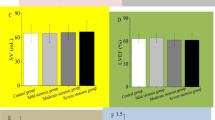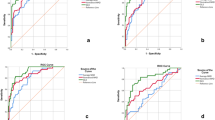Abstract
The aim of our study was to assess the diagnostic accuracy of a global longitudinal strain and strain rate (GLS, GLSR) and mean radial strain and strain rate (MRS, MRSR) of the left ventricle to predict multivessel disease. In 113 patients, who underwent coronary angiography, left ventricular deformation was analysed by speckle-tracking based velocity vector imaging. In three standard apical views strain and strain rate curves were generated corresponding with two opposite basal, mid, and apical segments. The negative peaks of systolic strain and strain rate from 18 curves were averaged as GLS and GLSR. Similarly, in short axis view 6 negative systolic peaks were averaged and considered as MRS and MRSR. Four subgroups were defined: (1) without significant coronary stenosis, 0-vessel disease (0VD), (2) single-vessel disease (1VD), (3) double-vessel disease (2VD), and (4) triple-vessel disease (3VD). In comparison with patients without significant coronary artery disease, all deformation indexes were significantly decreased in patients with 3VD. The left ventricular ejection fraction (LVEF) and wall motion score index (WMSI) showed lower significance level as deformation parameters. MRSR was the strongest predictor of multivessel disease. Receiver-operating characteristic curves (ROC) showed that MRSR had the highest diagnostic accuracy. Comparing ROC areas, MRSR had significantly higher diagnostic accuracy than LVEF and WMSI. The results of our study show that global deformation indexes have a good diagnostic accuracy in differentiating multivessel disease. MRSR tended to be better in identification of 3VD than traditional indexes of global and regional left ventricular function.





Similar content being viewed by others
References
Marwick TH (2006) Measurement of strain and strain rate by echocardiography: ready for prime time? J Am Coll Cardiol 47:1313–1327
Greenberg NL, Firstenberg MS, Castro PL, Main M, Travaglini A, Odabashian JA, Drinko JK, Rodriguez LL, Thomas JD, Garcia MJ (2002) Doppler-derived myocardial systolic strain rate is a strong index of left ventricular contractility. Circulation 105:99–105
Uren NG, Melin JA, De Bruyne B, Wijns W, Baudhuin T, Camici PG (1994) Relation between myocardial blood flow and the severity of coronary artery stenosis. N Engl J Med 330:1782–1788
Kowalski M, Kukulski T, Jamal F, D’Hooge J, Weidemann F, Rademakers F, Bijnens B, Hatle L, Sutherland GR (2001) Can natural strain and strain rate quantify regional myocardial deformation? A study in healthy subjects. Ultrasound Med Biol 27:1087–1097
Kaluzynski K, Chen X, Emelianov SY, Skovoroda AR, O’Donnell M (2001) Strain rate imaging using two-dimensional speckle tracking. IEEE Trans Ultrason Ferroelectr Freq Control 48:1111–1123
Koyama J, Ray-Sequin PA, Falk RH (2003) Longitudinal myocardial function assessed by tissue velocity, strain, and strain rate tissue Doppler echocardiography in patients with AL (primary) cardiac amyloidosis. Circulation 107:2446–2452
Weidemann F, Eyskens B, Mertens L, Di Salvo G, Strotmann JO, Buyse G, Claus P, D′hooge J, Bijnens B, Gewillig M, Sutherland GR (2003) Quantification of regional right and left ventricular function by ultrasonic strain rate and strain indexes in Friedreich’s ataxia. Am J Cardiol 91:622–626
Weidemann F, Breunig F, Beer M, Sandstede J, Turschner O, Voelker W, Ertl G, Knoll A, Wanner C, Strotmann JM (2003) Improvement of cardiac function during enzyme replacement therapy in patients with Fabry disease: a prospective strain rate imaging study. Circulation 108:1299–1301
Kato TS, Noda A, Izawa H, Yamada A, Obata K, Nagata K, Iwase M, Murohara T, Yokota M (2004) Discrimination of nonobstructive hypertrophic cardiomyopathy from hypertensive left ventricular hypertrophy on the basis of strain rate imaging by tissue Doppler ultrasonography. Circulation 110:3808–3814
Hoffmann R, Altiok E, Nowak B, Heussen N, Kühl H, Kaiser HJ, Büll U, Hanrath P (2002) Strain rate measurement by Doppler echocardiography allows improved assessment of myocardial viability in patients with depressed left ventricular function. J Am Coll Cardiol 39:443–449
Hanekom L, Jenkins C, Short L, Marwick TH (2005) Accuracy of strain rate techniques for identification of viability at dobutamine stress echo: a follow-up study after revascularization. Circulation 112:3892–3900
Liang HY, Cauduro S, Pellikka P, Wang J, Urheim S, Yang EH, Rihal Ch, Belohlavek M, Khandheria B, Miller FA, Abraham TP (2006) Usefulness of two-dimensional speckle strain for evaluation of left ventricular diastolic deformation in patients with coronary artery disease. Am J Cardiol 98:1581–1586
Choi JO, Cho SW, Song YB, Cho SJ, Song BG, Lee SC, Park SW (2009) Longitudinal 2D strain at rest predicts the presence of left main and three vessel coronary artery disease in patients without regional wall motion abnormality. Eur J Echocardiogr 10:695–701
Gjesdal O, Vartdal T, Hopp E, Lunde K, Brunvand H, Smith HJ, Edvardsen T (2009) Left ventricle longitudinal deformation assessment by mitral annulus displacement or global longitudinal strain in chronic ischemic heart disease: are they interchangeable? J Am Soc Echocardiogr 22:823–830
Lee R, Hanekom L, Marwick TH, Leano R, Wahi S (2004) Prediction of subclinical left ventricular dysfunction with strain rate imaging in patients with asymptomatic severe mitral regurgitation. Am J Cardiol 94:1333–1337
Reisner SA, Lysyansky P, Agmon Y, Mutlak D, Lessick J, Friedman Z (2004) Global longitudinal strain: a novel index of left ventricular systolic function. J Am Soc Echocardiogr 17:630–633
Delgado V, Mollema SA, Ypenburg C, Tops LF, van der Wall EE, Schalij MJ, Bax JJ (2008) Relation between global left ventricular longitudinal strain assessed with novel automated function imaging and biplane left ventricular ejection fraction in patients with coronary artery disease. J Am Soc Echocardiogr 21:1244–1250
D′Andrea A, Cocchia R, Caso P, Riegler L, Scarafile R, Salerno G, Golia E, Di Salvo G, Calabro P, Bigazzi MC, Liccardo B, Esposito N, Cuomo S, Bossone E, Russo MG, Calabro R (2010) Global longitudinal speckle-tracking is predictive of left ventricular remodeling after coronary angioplasty in patients with recent non-st elevation myocardial infarction. Int J Cardiol (Epub)
Yang ZR, Zhou QC, Lee L, Zou L, Zeng S, Tan Y, Cao DM (2011) Quantitative assessment of left vnetricular systolic function in patients with coronary heart disease by velocity vector imaging. Echocardiography (Epub)
Bochenek T, Wita K, Tabor Z, Grabka M, Krzych L, Wróbel W, Berger-Kucza A, Elźbieciak M, Doruchowska A, Gluzza MT (2011) Value of speckle-tracking echocardiography for prediction of left ventricular remodeling in patients with ST-elevation myocardial infarction treated by primary percutaneous intervention. J Am Soc Echocardiogr 24:1342–1348
Cho GY, Chan JCh, Leano R, Strudwick M, Marwick TH (2006) Comparison of two-dimensional speckle and tissue velocity based strain and validation with harmonic phase magnetic resonance imaging. Am J Cardiol 97:1661–1666
Conflict of interest
None.
Author information
Authors and Affiliations
Corresponding author
Rights and permissions
About this article
Cite this article
Valocik, G., Valocikova, I., Mitro, P. et al. Diagnostic accuracy of global myocardial deformation indexes in coronary artery disease: a velocity vector imaging study. Int J Cardiovasc Imaging 28, 1931–1942 (2012). https://doi.org/10.1007/s10554-012-0025-5
Received:
Accepted:
Published:
Issue Date:
DOI: https://doi.org/10.1007/s10554-012-0025-5




